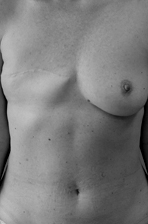Reconstruction with tissue from the abdomen
(TRAM-flap / DIEP-flap)
This form of reconstruction usually causes the most natural result, because skin and fat tissue from the abdomen are most similar to that of the breast. It therefore is our preferred procedure. Naturally, it requires enough abdominal fat tissue.
With the standard technique we use the abdominal fat tissue is transplanted freely.by an aid of an microscope. Skin and fat tissue together with a small part of the abdominal muscle and the supplying vessels are taken from the abdomen and sutured again at the breast under the microscope. The major advantage of this method is that not a whole muscle but only a small muscle sliver has to be taken so that the abdominal wall remains intact and the risk of a weakness to the abdominal wall is insignificant. Initially the time expended on this operation is clearly higher but generally leads to a more visually pleasing result. If we have to transplant a small part of the muscle as well, the operation is called TRAM-flap (Transverse Rectus Abdominis Muscle). If only a vessel from within the muscle is isolated and therefore the muscle mainly spared, the operation is called DIEP-flap (Deep Inferior Epigastric Perforator).
The abdominal fat flap can also be folded over up to the breast together with the whole muscle and remodelled as the new breast (pedicled TRAM-flap). However, this usually leaves an unsightly bulge above the costal arch and often an instability to the abdominal wall due to the abdominal muscle having been removed. We only carry out this operation if the free transplantation is not possible.
After 6 to 9 months the inner healing and scarring process are also finished and the tissue has reached its final form so that corrections such as tightening of the other breast to achieve symmetry, or the reconstruction of the nipple, can be carried out.
A positive side effect of TRAM or DIEP-flaps is that in order to close the abdomen again, the abdominal wall has to be tightened, leading to a "tummy tuck". Operation technique
The operation is carried out under general anaesthetic. The abdominal fat flap is transplanted to the breast together with its vessels and is connected to new vessels in the region of the ribcage or the armpits. The abdomen from which the tissue has been taken is closed again by means of an abdominoplasty ("tummy tuck"). For this the skin is lifted from the abdominal musculature and pulled down to the bottom. The navel is fitted in again. Risks and possible complications
In rare cases it may happen that the body does not accept the new tissue. The risk of this happening is below 2%. Here we can try to remove a possible existing thrombosis in the sutured vessels by operating repeatedly. Further risks are problems in healing of the abdominal wall as well as loss of the new navel, which then can be remodelled fairly easily, though in a later operation. However, these complications are extremely rare. We have not witnessed a weakness of the abdominal wall or tearing (hernia) of the abdominal wall amongst our patients. Follow-up treatment
The follow-up treatment is initially more thorough. Our patients are restricted to their beds and are treated by the nursing staff. Bed rest is important for the microsurgical vessel sutures to heal and the tissue to be supplied with blood properly. Furthermore, rest makes sense for the abdomen to achieve a good cosmetic result. Patients wear a stomach corset and a support bra day and night for 3 months in total to protect the tissue and to improve the look of the scars. Overtaxing the upper body should be stopped for 3 months in total.
We recommend operations for correction after 6 to 9 months at the earliest, that is after the inner scars have healed off completely. Included in the correcting operations are adjusting the tightening of the other breast and, of course, the remodelling of the nipple. However, all assimilating procedures should have been finished before this last operation.




